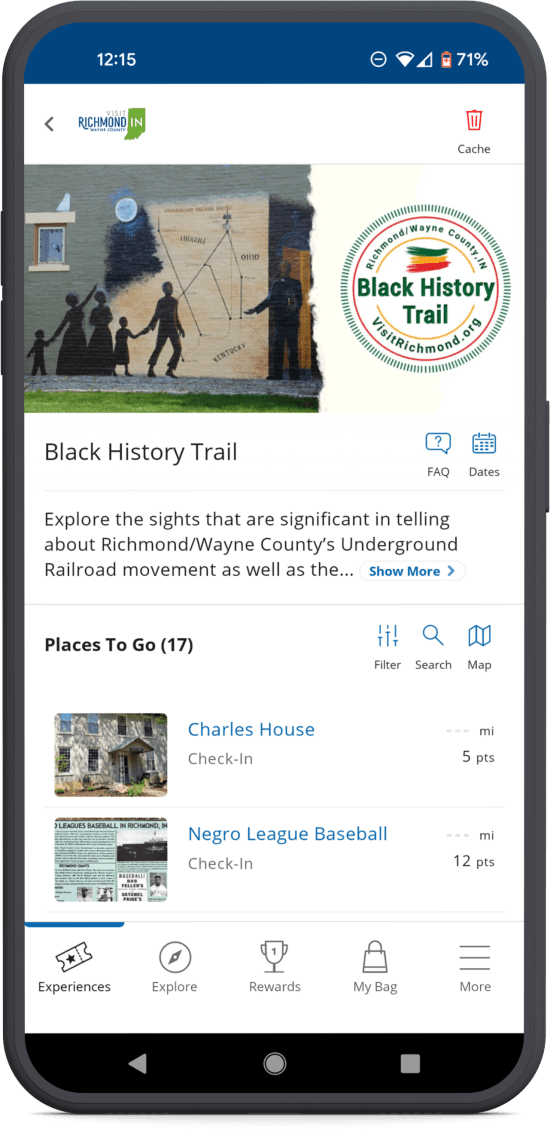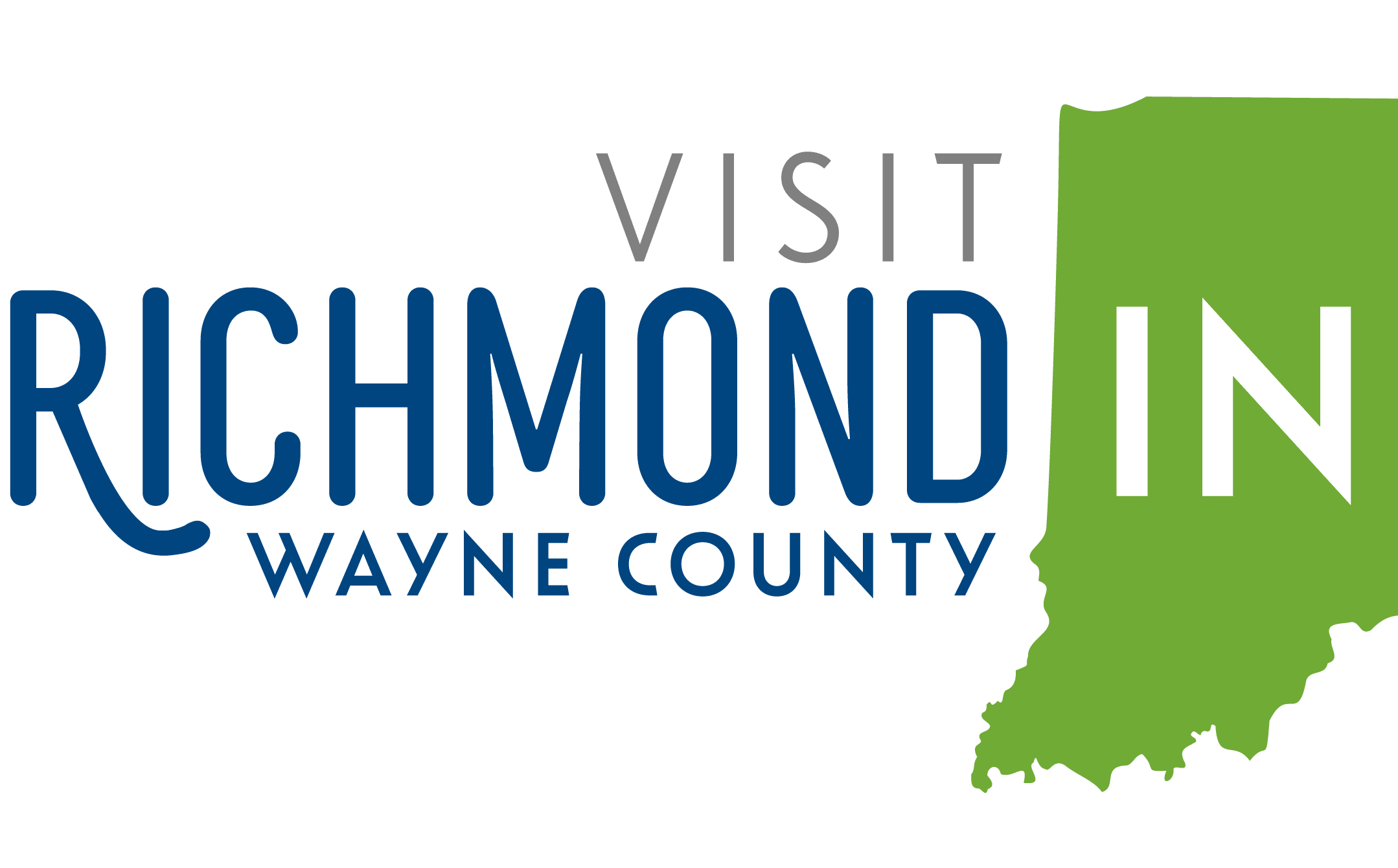
Black History Trail
Explore the sights that are significant in telling about Wayne County’s Underground Railroad movement as well as the history, music, culture, entrepreneurship, and contributions of Wayne County's Black community. They blazed many trails. Now retrace their footsteps.
How this Pass Works

Step 1 - Get Your Pass
This mobile exclusive passport is a collection of curated attractions and historical sites across Wayne County.

Step 2 - Receive Text
Your passport will be instantly delivered to your phone via text and email and is ready to use immediately! There is no app to download. Your pass can be saved to your phone’s home screen for easy one-tap access.

Step 3 - Redeem
When visiting a participating site, check-in on your phone to earn points toward prizes!
Included Venues

See locations on an interactive map.
Bishop William Paul Quinn Historical Marker & Bethel AME Church
At the time of its founding in 1816, the African Methodist Episcopal Church (AME) was the first independent Black denomination in the country.
In the early 1830s, William Paul Quinn was ordained to preach in the African Methodist Episcopal (AME) Church. He established AME churches in OH, IN, IL, MO, and KY. In 1836, the first two churches in Indiana were founded, one in Richmond and the other in Indianapolis. Richmond’s place of worship was gifted to the AME congregation from the local Hicksite Friends parishioners.
In 1844, the AME General Conference elected Quinn as the fourth Bishop. Quinn denounced slavery in sermons and publications and aided the work of the Underground Railroad.
In the mid-1830s, Richmond gained the nickname “Little Africa” because Black people migrated to the city in larger numbers than white people. The Black community centered around the Bethel AME church.
Show more
C & W Bar-B-Que
This Black-owned local BBQ restaurant features mouthwatering meals ranging from ribs to chicken, pork chops to fish, and plenty more. Select the BBQ sauce that fits your style; mild, medium, or hot.
Open Friday & Saturday evenings only.
Charles House
In 1814, abolitionist Quaker Samuel Charles from North Carolina homesteaded in what became known as Richmond. His nickname was “Righteous Sammy Charles,” and he had a secret. He was a conductor on the Underground Railroad.
A May 1907 Palladium-Item newspaper article about the restoration of the Charles House stated, “as the plastered addition to the old Charles home was being torn down, a secret cellar was found. This cellar is about 8 x 8 feet, and it is thought that this cellar during the antebellum days was used to secrete slaves fleeing along the Underground Railroad to Canada and freedom. This cellar has brick flooring and brick walls. It’s about four and a half feet deep, and the air is admitted to it by an air chamber through the ground. While park supervisor W.F. Kloop and a gang of men were working Wednesday, tearing down the addition, an old Negro man, with whom none of the men were acquainted, approached and inquired if the secret cellar had been discovered. He was told that nothing was known of such a cellar. The old man knocked away some dust and rubbish on the floor of the addition, and finally disclosed to the astonished workmen the probable hiding place of the slaves. An old ladder, in badly dilapidated condition, led to the brick floor and the little cellar. People acquainted with the old house state that they never knew of this hiding place, as they thought the only cellar in the house was under the brick wing.”
The Charles house is one of the oldest houses in Richmond.
Show more
Firehouse BBQ and Blues
Firehouse BBQ and Blues is a popular restaurant located in Richmond, Indiana, known for its delicious barbecue dishes and live blues music. Situated at 400 N 8th St, this cozy establishment offers a casual and inviting atmosphere for patrons to enjoy a unique dining experience. The menu features a variety of smoked meats, including brisket, ribs, pulled pork, and chicken, all cooked to perfection and served with their signature homemade BBQ sauces. In addition to the mouthwatering barbecue options, Firehouse BBQ and Blues also offers a selection of hearty sides, such as mac and cheese, coleslaw, baked beans, and cornbread.
One of the standout features of the restaurant is their live blues music performances, which can be enjoyed while dining or simply sipping on a refreshing drink at the bar. The talented musicians create a lively and entertaining ambiance, making Firehouse BBQ and Blues a favorite spot for locals and visitors alike. Whether you're looking for a casual meal with friends, a fun night out with live music, or a place to relax and enjoy some good old-fashioned barbecue, Firehouse BBQ and Blues is the perfect destination. So, come on down to 400 N 8th St and let your taste buds be tantalized by the mouthwatering flavors and your ears serenaded by soulful blues tunes at Firehouse BBQ and Blues in Richmond, Indiana.
Show more
Gennett Records Mural – Charley Patton
As a Delta Country Blues performer, Patton wrote and recorded numerous classics. Known as an iconic guitar player, Patton is sometimes renowned as the Founder of the Delta Blues.
Gennett Records Mural – Gennett Firsts
This mural is of a few Gennett Records recording artists who made history. Heads are 5 feet tall, and the star is 21 feet tall. Music artists included in the mural are Louis Armstrong, Lil Hardin Armstrong, Bix Beiderbecke, Gene Autry, Lawrence Welk, Jelly Roll Morton, and studio owner Gennett.
Gennett Records Walk of Fame
During the early 20th century, one small, humble recording studio in Richmond had a major ripple effect on the American Black music industry. The Gennett label was noteworthy for recording and promoting Black musicians at a time when few others would do so.
A legendary roster of black musicians recorded music at Richmond’s Gennett Recording Studio - greats like Louis Armstrong, Duke Ellington, Bix Beiderbecke, Blind Lemon Jefferson, and Charley Patton, among others.
The Gennett Walk of Fame honors many Black musical artists. The walk consists of large ceramic and bronze medallions resembling 78 rpm records featuring the images of the entertainers. “America’s greatest contribution to cultural history is its music, and no matter what kind of music you listen to, it’s been influenced directly by the records made by those artists of Gennett records.”
—Charlie Dahan, Professor, Department of Recording Industry, Middle Tennessee State University
Show more
George Washington Julian Interpretive Marker
Julian was a long-time Centerville resident and a steadfast abolitionist who advocated for equal rights for men and women, Black and white. Julian worked within the legal system and various political parties to achieve goals shaped by his Quaker moral convictions. His commitment to abolition and equal rights (including equality in land distribution) remained remarkably consistent for over fifty years. Julian served as a U.S. representative from 1849-1851 and again from 1861-1871.
In 1850, Congress passed the Fugitive Slave Act, which not only prohibited Hoosiers from aiding escaping slaves but required them to return self-emancipated African Americans to their enslavers. Many opposed the law and challenged it in the courts. In the 1850s, Julian acted as a lawyer both for African Americans who were claimed as slaves and for those white Hoosiers who had helped slaves escape. According to Riddleberger, "after 1850 a lawyer in any of the states lying on the north shore of the Ohio River could, if he were so inclined, devote some of his practice to fugitive slave cases.”
Julian's primary political goal in the 1850s and 1860s was the abolition of slavery and challenging its expansion into the western United States. He helped secure the passage of the 1862 Homestead Act and called for the abolition of slavery.
Show more
Levi & Catharine Coffin State Historic Site
A Quaker, abolitionist, and business owner, Levi Coffin was born in Guilford County, NC. He and his wife, Catharine, moved to Newport (now Fountain City) in 1826 and immediately started to assist runaway slaves.
Levi and Catharine Coffin’s home, known as the Grand Central Station of the Underground Railroad, served as a safe haven that sheltered more than 1,000 freedom-seekers and aided them in their flight to Canada.
The Interpretive Center delivers a moving and unforgettable experience. The tour begins with a 12-minute orientation video to learn about the Coffins’ role in helping thousands find their way north. The Center is also full of interactive exhibits symbolizing and celebrating the spirit, grit, and courage of the men and women who fled slavery and the active abolitionists who assisted them in their flight. Admission is charged.
When touring the 1839 Coffin home, you will see actual hiding places the Coffins used to safely shelter the freedom seekers. You’ll also find unique features like a spring-fed well and kitchen in the basement.
The Coffin House has been ranked by The History Channel as one of the nation’s Top 25 Historical Sites.
Show more
Longtown - Clemens Farmstead
The earliest settlement of free Blacks in Indiana was the Greenville Settlement in Randolph County, Indiana and Darke County, Ohio known as Longtown, founded before the Civil war circa 1818. They were the sons and daughters of slave masters, free Blacks, Europeans and Native Americans.
The settlement once covered an area of approximately ten square miles and had a population of about 900. Like many such free communities, people were almost all farmers. Historians hypothesize the settlers chose this location so if one state passed laws that were too restrictive for people of color, they could easily move to the other state.
Several residents were Underground Railroad conductors assisting escaped slaves on their journey to Canada. Many of its young men fought in the Civil War and are buried in the community’s cemeteries. Around 1880, the population of the settlement begin to decline, with residents relocating to nearby cities for work and opportunity. Just a few families remain and continue to farm their ancestral land. Many people in the greater Richmond area have Longtown roots.
Just a few structures remain of the once vibrant community:
The Clemens Farmstead – James Clemens, a freed slave from Virginia, purchased land and settled the area in 1818. Clemens became a prosperous farmer and around 1850 he erected a brick Federal home which is still standing and is currently being restored. The house is listed on the National Register of Historic Places, recognized as an Underground Railroad site by the National Park Service, and has an Ohio Historical Marker.
Bethel Long Wesleyan Church – The church has been around for 161 years. It’s located in the heart of Longtown and it still holds Sunday morning services. Many Longtown descendants attend this church.
Longtown has three cemeteries -- Clemens Cemetery (Ohio side), Bass Cemetery (Ohio side), and Alexander Cemetery (Indiana side).
Show more
Negro League Baseball
For decades, hundreds of Black baseball players were barred from the major leagues on account of their skin color. Thus, African Americans established their own leagues, barnstorming around the country to play anyone who would challenge them.
Between 1907 - 1960, Richmond continuously hosted the traveling Negro League teams; in all, more than 125 games involving all-Black teams were played here. This includes the 1918 Richmond Giants, the city’s own black baseball team which featured several prominent ballplayers. In all, twenty Baseball Hall of Famers came through Richmond with their Negro League teams. This includes such legends as Satchel Paige, Josh Gibson, ‘Cool Papa’ Bell, and Oscar Charleston.
In addition to McBride Stadium, many of the games were played at Exhibition Park, which stood from 1917 through 1935. The 2,500-seat stadium was located on the south side of U.S. 40 – across the street from the interpretive sign.
Show more
Underground Railroad Mural – Fountain City
Levi & Catharine Coffin were American Quakers, abolitionists, and humanitarians. This mural memorializes Levi and Catharine Coffin and their role in the Underground Railroad.
The Coffins worked tirelessly to aid slaves toward freedom. Tour the Levi & Catharine Coffin State Historic site just two blocks north and follow the freedom seeker's footsteps to safety.
Show more
Underground Railroad Mural – Richmond
Escaped slaves fled north towards freedom, often by the safety of night as they followed the north star, located by finding the “Drinking Gourd” (Big Dipper Constellation). This mural highlights Wayne County's important contribution to the Underground Railroad.
Union Literary Institute building (1846)
With the exclusion of minorities from early public schools in Indiana, settlers of Longtown and their Abolitionist Quaker neighbors founded the Union Literary Institute (circa 1845) to offer higher education without regard to color or sex. Students could pay their tuition by living in a dormitory on campus and working half days in the fields before classes. In 1860, the hewn log school was replaced by the two-story brick school that is standing today as a ruin. However, plans to restore the building are in the works.
Notable attendees included Hiram Revels, the first black U.S. Senator, and James S. Hinton, the first black elected to the Indiana House of Representatives.
In addition to its significance as an early educational institution, the Institute was a station on the Underground Railroad. Levi Coffin, known nationally as “the President of the Underground Railroad” was a member of the Institute’s Board of Managers.
Show more
Wayne County Historical Museum
The Birthplace of American Recorded Music Exhibit - This enriching exhibit showcases the history of early recorded music and some of the artists who recorded at Richmond’s Gennett Recording Studio. The Gennett family is credited for recording Black musicians when many other recording studios wouldn’t.
William Bush Gravesite
Sometime in the 1840s, William Bush, a freedom seeker from Person County, NC, arrived in Newport (now Fountain City). Oral history states, Bush escaped from bondage by having himself shipped in a wooden crate to Newport in the care of Levi Coffin.
Bush decided to remain in Newport. He was a successful blacksmith, and he became a conductor on the Underground Railroad and helped other fugitive slaves on their trek to freedom. He won the town’s gratitude when, during an epidemic, he dared to bury the dead.
Bush died in 1898 and is buried at Fountain City’s Willow Grove Cemetery. His grave reads: William Bush “slave” – Assisted Levi Coffin with the slaves flight from bondage to freedom. Five generations of his direct descendants lived in Fountain City.
The wooden shoes he once wore are on display at Levi & Catharine Coffin State Historic Site.
Show more
William Paul Quinn Gravesite
Quinn came to America in the early 1830s and was associated with the Quaker faith; however, he soon converted to Methodist Episcopalian.
In 1836, he was appointed missionary and sent to the Western frontier, from Ohio to Missouri, to organize AME churches. Quinn made Richmond his home and base of operations.
Throughout the rest of his life, he was a highly esteemed member of the community. His funeral in 1873 had to be held in the Pearl Street ME Church because the Bethel Church was too small to hold the large number of mourners. He is buried at Earlham Cemetery, Richmond.
Show more
